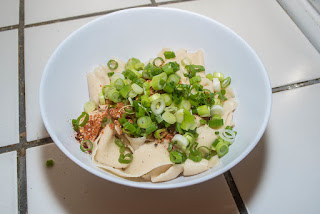Biang Biang Noodles are a Chinese noodle dish originating in the Shaanxi province of China. The name "biang" refers to the sound made when the dough is stretched during the noodle-making process. The noodles are traditionally made by hand and can be served with various toppings such as meat and vegetables. They are known for their chewy texture and are considered a specialty dish in Shaanxi cuisine.
What is biang biang noodle?
Biang biang noodles are known for their thick, comprehensive, and chewy texture. They are made from wheat flour, and sometimes with the addition of other grains such as corn or barley. The dough is rolled out and stretched by hand to create thick, flat noodles. The texture is often described as chewy and elastic. The dish is often served with a spicy or savory sauce and various toppings such as meat and vegetables.
What does biang biang noodle taste like?
Biang biang noodles are known for their chewy texture and unique taste. The wheat-based dough gives them a slightly nutty and wheaty flavor, while the different sauces and toppings can add spicy, savory, or slightly sweet notes to the overall taste. The noodles are typically served with a spicy or savory sauce, which can include chili oil, vinegar, and soy sauce, which gives the dish a bold and robust flavor. Additionally, toppings such as meat and vegetables can add different textures and flavors to the dish. Some people describe the taste of the Biang biang noodles as strong and unique, which can be addictive for those who enjoy bold and spicy food.
How to pull the noodles?
Pulling the noodles for Biang Biang Noodles can be a bit tricky, but with practice, you can get the hang of it. Here are a few tips to help you pull the perfect noodles:
Begin by way of dividing the dough into eight same quantities. Roll each portion into a long rope about 1/2 inch thick.
Place a rope of dough on a floured surface and press it down with your palms to flatten it slightly.
Hold the ends of the rope with your hands, and then use your thumbs to press down on the middle of the rope, stretching it out.
Rotate the rope as you stretch it out to ensure that it stretches evenly. Keep stretching and rotating the dough until it becomes about 2 inches wide and 1/4 inch thick.
Use a sharp knife or a pizza cutter to cut the stretched dough into noodles that are around 2 inches wide and 8 inches long.
Repeat the procedure with the remaining portions of dough.
Practice is key to making perfect noodles, so don't get discouraged if your first attempt doesn't turn out perfectly. With each try, you will improve your skills.
Ingredients:
2 cups (250g) all-purpose flour
1/2 cup (70g) wheat starch
1/2 cup (70g) hot water
1 tsp salt
Oil, for cooking
Instructions:
In a large mixing bowl, combine the all-purpose flour, wheat starch, and salt.
Slowly add the hot water to the dry ingredients and mix until a dough forms.
Knead the dough on a floured surface for about 10 minutes, or until it becomes smooth and elastic.
Cover the dough with a damp cloth and let it rest for about 20 minutes.
Divide the dough into 8 equal portions and roll each one into a long rope about 1/2 inch thick.
Take one rope and stretch it out by hand, until it becomes about 2 inches wide and 1/4 inch thick.
Cut the stretched dough into noodles that are around 2 inches wide and 8 inches long.
Bring a pot of water to a boil and cook the noodles for 1-2 minutes, or until they float to the surface.
Drain the cooked noodles and toss them in a small amount of oil to prevent them from sticking together.
Serve the biang biang noodles with your desired sauce and toppings.
Note: The dough can be very difficult to stretch, so it's best to practice in order to get the perfect texture.
This recipe is just a basic guide, there are variations that can be made based on the ingredients and preferences. Enjoy!



